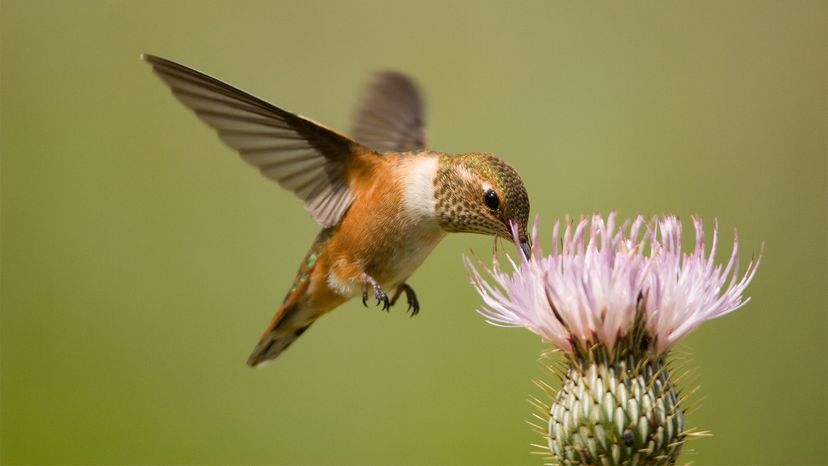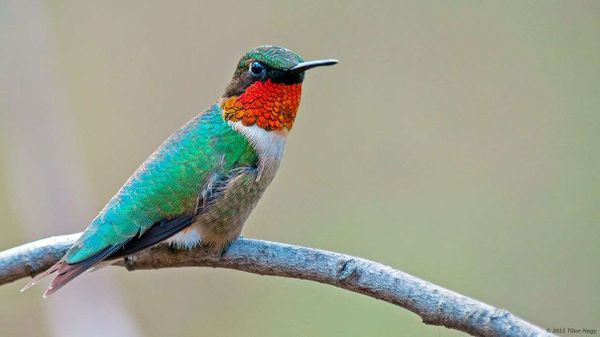
With the advent of springtime, hummingbirds are on the move and many bird watchers and backyard enthusiasts put out feeders to attract the playful — and nectar-competitive — avians, which has engendered a lot of discussion about what to feed hummingbirds. What's good for them, and what's to be avoided?
Food is energy, and the hummingbird needs a lot of it to survive. Every year — from late winter into spring — the .12-ounce (0.003-kilogram) bird flies about 3,400 miles (5,470 kilometers) from its winter sites in Mexico to summer breeding spots as far north as Alaska. It doesn’t need a smartphone to get there, either — it relies on radar instinct that, as some watchful hummingbird fans have noted, guides the birds back to the same bird feeders year after year.
It's a long and perilous journey — but hummingbirds can fly like no other bird. They get their name from the "hummmmm" their fast wings make. First-time viewers, noting the sound and aerial maneuvers, often wonder if hummers are oversized flying insects.
We spoke with Jason Ward with the Atlanta chapter of the Audubon Society, and he gave us the lowdown on what hummingbirds really need to satisfy their energy-guzzling metabolism, what we should feed them in our own backyards.
Advertisement
Q: What do you like most about hummingbirds?
A: I love the fact that they're biological marvels. We're talking about a bird whose heart beats about 1,200 times per minute, flaps its wings about 100 times per second, and weighs less than a nickel! Not only that, but ruby-throated hummingbirds, the kind we all know and love in the eastern U.S., migrate 500 miles (805 kilometers) by flying over the Gulf of Mexico! It's something we still don't know much about, since these birds need to feed every 10 minutes or so due to their high metabolism.
Q: What is the crux of the debate about how and what to feed hummingbirds?
A: Hummingbirds have pretty good eyesight and are attracted to reddish-colored flowers. To increase the probability of hummingbirds visiting feeders, some people have decided to put red food coloring in their nectar solution. There are plenty of theories about the potential harm this red food dye can cause hummers — from it thinning their egg shells out, to building up in their livers and kidneys. The truth is, those claims are unsubstantiated. We don't know for sure if red food dye harms hummingbirds. But until we're able to figure it out for sure, it's probably best not to use it at all.
Q: What is in red dye (or any color dye) that could be harmful?
A: We don't know. Most of the claims that colored dye is harmful are likely urban legend. Still, the use of the dye is unnecessary.
Q: What's your advice on what to feed them?
A: It's really simple. The solution should be one part sugar, four parts water. That is all.
Advertisement
Q: What about water? Should we set out something for them to drink?
A: Hummingbirds will get most of the water they need to drink from nectar. But they'll use water features to bathe in. However, normal-sized bird baths aren't a good idea here; they're simply too deep for hummingbirds. Instead, misters, fountains or slow drippers are best, since they can provide shallow areas for hummingbirds to bathe in.
Q: What do hummingbirds give us, or the environment? Why are they important? What's their place in the grand scheme?
A: They're major pollinators! For wildflowers, shrubs and trees here in the U.S. They also assist in keeping insect populations in check by eating small, mosquito-sized insects and small spiders.
Q: Aside from feeders, what flora attracts hummingbirds?
A: In the U.S., the best flowers for hummers are going to be colorful, long and tubular. Here's a short list:
- Trumpet vine (aka, trumpet creeper)
- Trumpet honeysuckle
- Red cardinal flower
- Bee Balm
Q: What preys on them?
A: Many animals prey on hummingbirds. Large insects such as the robber fly and the invasive Chinese mantis have been known to catch hummers, snakes and bullfrogs. And most birds will dine on hummer. One of the biggest threats to hummers, in addition to most birds, are feral cats. Which is why responsible pet ownership involves keeping your cat indoors.
Q: Where do they live? In nests?
A: That depends on the species. Here in the eastern U.S., our ruby-throated hummingbirds build nests between 10 and 20 feet (3 and 6 meters) high in trees, on average. Nests are tiny and made out of grasses, plant fibers, dead leaves and spider webs.
Advertisement
Q: What's one thing people don't know about hummers?
A: In order to sleep, hummers enter a state called "torpor." It's a hibernation-like state that allows them to conserve energy. They slow their heart rates down to 50 beats per minute, appear to stop breathing and will even hang upside down!
Q: Got any cool hummingbird stories to share?
A: I lead monthly bird walks in Piedmont Park in Atlanta. Last springtime, we were treated to some hummingbird courtship. When a male ruby-throated hummingbird sees a female he likes, he engages in this elaborate display, swinging back and forth in midair like a pendulum, while she watches from a nearby perch. It's really cool and fun to watch. It was easily the highlight of my bird walk that morning.
Learn more about hummingbirds in "Hummingbirds of North America: The Photographic Guide" by Steve N.G. Howell. HowStuffWorks picks related titles based on books we think you'll like. Should you choose to buy one, we'll receive a portion of the sale.
Advertisement

